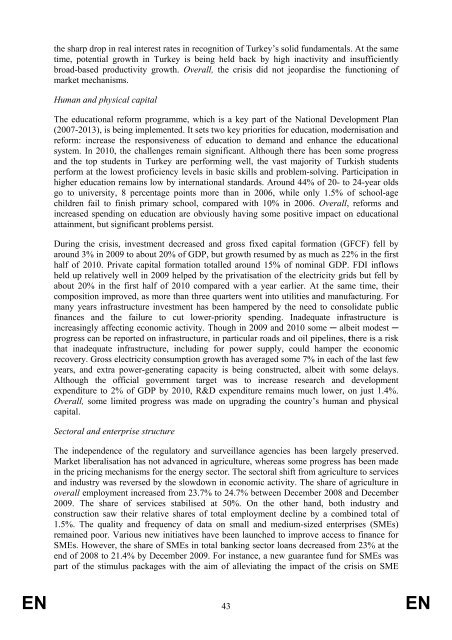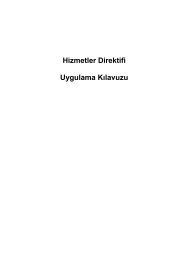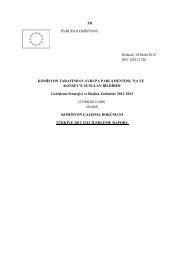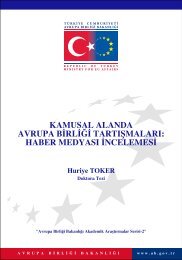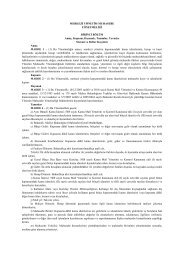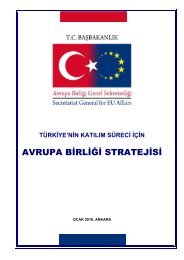2010 ilerleme raporu - Avrupa Birliği Bakanlığı
2010 ilerleme raporu - Avrupa Birliği Bakanlığı
2010 ilerleme raporu - Avrupa Birliği Bakanlığı
You also want an ePaper? Increase the reach of your titles
YUMPU automatically turns print PDFs into web optimized ePapers that Google loves.
the sharp drop in real interest rates in recognition of Turkey’s solid fundamentals. At the sametime, potential growth in Turkey is being held back by high inactivity and insufficientlybroad-based productivity growth. Overall, the crisis did not jeopardise the functioning ofmarket mechanisms.Human and physical capitalThe educational reform programme, which is a key part of the National Development Plan(2007-2013), is being implemented. It sets two key priorities for education, modernisation andreform: increase the responsiveness of education to demand and enhance the educationalsystem. In <strong>2010</strong>, the challenges remain significant. Although there has been some progressand the top students in Turkey are performing well, the vast majority of Turkish studentsperform at the lowest proficiency levels in basic skills and problem-solving. Participation inhigher education remains low by international standards. Around 44% of 20- to 24-year oldsgo to university, 8 percentage points more than in 2006, while only 1.5% of school-agechildren fail to finish primary school, compared with 10% in 2006. Overall, reforms andincreased spending on education are obviously having some positive impact on educationalattainment, but significant problems persist.During the crisis, investment decreased and gross fixed capital formation (GFCF) fell byaround 3% in 2009 to about 20% of GDP, but growth resumed by as much as 22% in the firsthalf of <strong>2010</strong>. Private capital formation totalled around 15% of nominal GDP. FDI inflowsheld up relatively well in 2009 helped by the privatisation of the electricity grids but fell byabout 20% in the first half of <strong>2010</strong> compared with a year earlier. At the same time, theircomposition improved, as more than three quarters went into utilities and manufacturing. Formany years infrastructure investment has been hampered by the need to consolidate publicfinances and the failure to cut lower-priority spending. Inadequate infrastructure isincreasingly affecting economic activity. Though in 2009 and <strong>2010</strong> some ─ albeit modest ─progress can be reported on infrastructure, in particular roads and oil pipelines, there is a riskthat inadequate infrastructure, including for power supply, could hamper the economicrecovery. Gross electricity consumption growth has averaged some 7% in each of the last fewyears, and extra power-generating capacity is being constructed, albeit with some delays.Although the official government target was to increase research and developmentexpenditure to 2% of GDP by <strong>2010</strong>, R&D expenditure remains much lower, on just 1.4%.Overall, some limited progress was made on upgrading the country’s human and physicalcapital.Sectoral and enterprise structureThe independence of the regulatory and surveillance agencies has been largely preserved.Market liberalisation has not advanced in agriculture, whereas some progress has been madein the pricing mechanisms for the energy sector. The sectoral shift from agriculture to servicesand industry was reversed by the slowdown in economic activity. The share of agriculture inoverall employment increased from 23.7% to 24.7% between December 2008 and December2009. The share of services stabilised at 50%. On the other hand, both industry andconstruction saw their relative shares of total employment decline by a combined total of1.5%. The quality and frequency of data on small and medium-sized enterprises (SMEs)remained poor. Various new initiatives have been launched to improve access to finance forSMEs. However, the share of SMEs in total banking sector loans decreased from 23% at theend of 2008 to 21.4% by December 2009. For instance, a new guarantee fund for SMEs waspart of the stimulus packages with the aim of alleviating the impact of the crisis on SMEEN 43 EN


